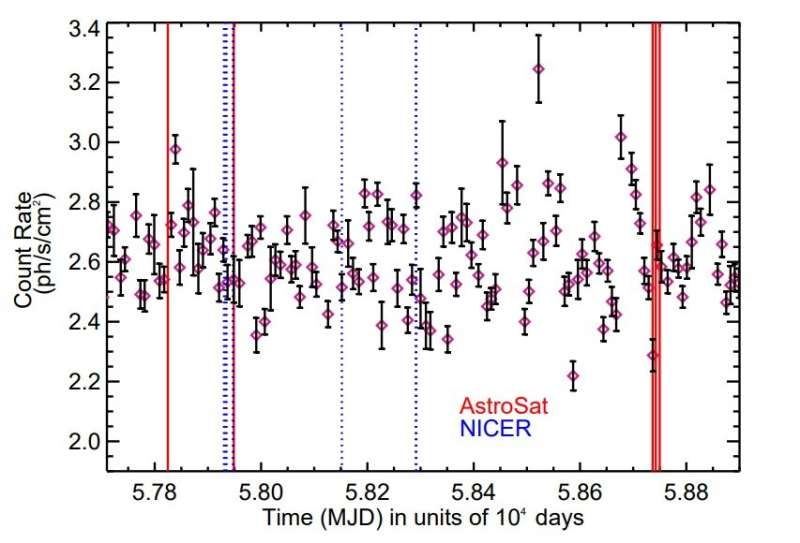May 31, 2023 report
This article has been reviewed according to Science X's editorial process and policies. Editors have highlighted the following attributes while ensuring the content's credibility:
fact-checked
preprint
trusted source
proofread
Study investigates the behavior of X-ray binary GX 349+2

Using the AstroSat spacecraft and the Neutron star Interior Composition Explorer (NICER) onboard the International Space Station (ISS), Indian astronomers have observed an X-ray binary known as GX 349+2. Results of the observational campaign, published May 24 on the arXiv preprint server, deliver important insights into the behavior and nature of this system.
Generally, X-ray binaries (XRBs) are composed of a normal star or a white dwarf transferring mass onto a compact neutron star or a black hole. Based on the mass of the companion star, astronomers divide them into low-mass X-ray binaries (LMXB) and high-mass X-ray binaries (HMXB).
Neutron star (NS) LMXBs are further divided into atoll and Z sources. The so-called atoll-type systems share some characteristics with black hole LMXBs as they have similar X-ray spectra and timing properties. However, they differ in their radio properties where atoll sources are 27 times less radio luminous.
When it comes to the Z sources (classified into two sub-classes: Cyg-like and Sco-like sources), they evolve much more quickly than those of atoll-type. In general, they are more X-ray and radio luminous than atoll sources. The Z sources trace out Z-shaped tracks in the hardness intensity diagrams (HIDs) consisting of three branches, called horizontal branch (HB), normal branch (NB) and flaring branch (FB).
GX 349+2 is a Sco-like Z source neutron star LMXB at a distance of some 30,000 light years. It is a peculiar system among all the known Z sources as it displays only the normal branch and flaring branch. Therefore, a team of astronomers led by Unnati Kashyap of the Indian Institute Technology Indore (IIT Indore) decided to investigate GX 349+2 in order to better understand this peculiarity.
"In this work, we report a broadband investigation of the Sco-like peculiar Z-source GX 349+2 using AstroSat and NICER. The X-ray instruments onboard AstroSat observed the source in its NB/FB vertex (the soft apex known as the boundary between stable and unstable nuclear burning and FB branch of its Z-track," the researchers wrote.
AstroSat observations found that GX 349+2 exhibits a large-scale variability in its flaring branch and normal branch/flaring branch vertex. During the NICER observations, the source was possibly in the NB branch of its Z-track as no flaring activities were visible during the monitoring.
According to the study, the power spectra showcase a very low-frequency noise (VLFN) and low-frequency noise (LFN)/flaring branch noise (FBN), described by a power law and an evolving Lorentzian component. It was found that the source moves along the Z track, with the increasing accretion rate, further heating of the neutron star boundary layer, and increasing temperature/radius of the brightened hotspot at the disk-boundary layer interface/neutron star surface.
Furthermore, the observations of GX 349+2 found the presence of hard lag at very low frequencies represented by the accretion disk fluctuation, which seems to suggest that VLFNs originate from the accretion disks in NS LMXB systems.
The authors of the paper propose further broadband and sensitive study of Z-type NS LMXB sources in order to better understand flaring behavior during the flaring branch, the source geometry, inclinations and the evolution of the companion object in such systems.
More information: Unnati Kashyap et al, Broadband spectro-temporal investigation of neutron star low-mass X-ray binary GX 349+2, arXiv (2023). DOI: 10.48550/arxiv.2305.15607
Journal information: arXiv
© 2023 Science X Network


















